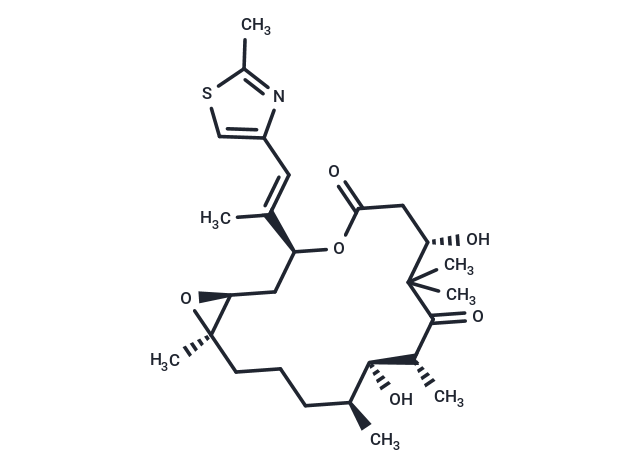Shopping Cart
- Remove All
 Your shopping cart is currently empty
Your shopping cart is currently empty

Epothilone B (EPO 906) is a compound isolated from the myxobacterium Sorangium cellulosum. Similar to paclitaxel, patupilone induces microtubule polymerization and stabilizes microtubules against depolymerization conditions. In addition to promoting tubulin polymerization and stabilization of microtubules, this agent is cytotoxic for cells overexpressing P-glycoprotein, a characteristic that distinguishes it from the taxanes. Patupilone may cause complete cell-cycle arrest.

| Pack Size | Price | Availability | Quantity |
|---|---|---|---|
| 1 mg | $30 | In Stock | |
| 2 mg | $43 | In Stock | |
| 5 mg | $61 | In Stock | |
| 10 mg | $101 | In Stock | |
| 25 mg | $226 | In Stock | |
| 50 mg | $409 | In Stock | |
| 100 mg | $596 | In Stock | |
| 1 mL x 10 mM (in DMSO) | $67 | In Stock |
| Description | Epothilone B (EPO 906) is a compound isolated from the myxobacterium Sorangium cellulosum. Similar to paclitaxel, patupilone induces microtubule polymerization and stabilizes microtubules against depolymerization conditions. In addition to promoting tubulin polymerization and stabilization of microtubules, this agent is cytotoxic for cells overexpressing P-glycoprotein, a characteristic that distinguishes it from the taxanes. Patupilone may cause complete cell-cycle arrest. |
| Targets&IC50 | Tubulin:1.8 μM(EC0.01) |
| In vitro | Epothilone B shows better activity than Epothilone A. The EC0.01 of Epothilone B is 1.8 μM. Epothilone B potently inhibits cell proliferation in HCT116 cells, with IC50 of 0.8 nM. [1] Epothilone B induces mitotic arrest and displays cytotoxicity in KB3-1, KBV-1, Hela, and Hs578T cells, with IC50 of 3 nM to 92 nM. Epothilone B competes with Taxol in binding to microtubules, with IC50 of 3.3 μM. [2] In MCF-7 cells overexpressing GFP-α-tubulin, Epothilone B (3.5 nM) efficiently blocks microtubule dynamics. Meanwhile, Epothilone B induces mitotic arrest with IC50 of 3.5 nM. [3] In multiple myeloma (MM) cells, including RPMI 8226, U266, MM.1S, LR5, and MR20, Epothilone B directly suppresses proliferation with IC50 of 1 nM to 10 nM. Similarly, Epothilone B (10 nM) also induces cell cycle arrest and apoptosis. [4] A recent study reveals that, in ovarian cancer Hey cells, Epothilone B (5 nM–100 nM) enhances surface epithelial cell adhesion antigen (EpCAM), without affecting the transcription or the total cellular level of EpCAM. [5] |
| In vivo | In a mouse xenograft model of RPMI 8226 cells, Epothilone B (2.5 mg/kg–4 mg/kg) prolongs survival and suppresses tumor growth. [4] Similarly, in mouse xenograft models of prostate cancer cells, including DU145 and PC3, Epothilone B at the same dose also inhibits tumor growth. [6] |
| Kinase Assay | Tubulin polymerization assay: Calf brain microtubule proteins (MTP) are purified, which includes approximately 15%–20% microtubule associated proteins. The buffer (MES buffer) used for the Epothilone B-microtubule studies contains 0.1 M 2-morpholinoethanesulfonic acid (MES), 1 mM EGTA, 0.5 mM MgCl2, and 3 M glycerol at pH 6.6. Samples for electron microscopy are placed on carbon-over-Parlodion-coated grids (300 mesh) and negatively stained with 2% uranyl acetate. Microtubule assembly in the presence or absence of Epothilone B is monitored spectrophotometrically by using a spectrophotometer equipped with a thermostatically regulated liquid circulator. The temperature is held at 35 °C and changes in turbidity (representative of polymer mass) are monitored at 350 nm. Effective concentration (EC0.01), defined as the interpolated concentration capable of inducing an initial slope of 0.01 OD/min rate, is calculated using the formula EC0.01 = concentration/slope and expressed as the mean with standard deviation obtained from three different concentrations. |
| Cell Research | For mitotic block and aberrant mitosis, cells are plated either in 48-well plates (for trypan blue and cell counting) or onto coverslips. After 24 hours, cells are treated with Epothilone B and scored at regular intervals. For the cytotoxicity analysis, cells are counted and scored as trypan blue positive or negative. Concurrently, coverslips andaliquots of cells in the culture supernatant are fixed and stained with Hoechst33342 in PBS. These cells are scored for cells blocked at the G2/M transition and aberrant mitosis.(Only for Reference) |
| Alias | Patupilone, EPO 906 |
| Molecular Weight | 507.68 |
| Formula | C27H41NO6S |
| Cas No. | 152044-54-7 |
| Smiles | C[C@H]1CCC[C@@]2(C)O[C@H]2C[C@H](OC(=O)C[C@H](O)C(C)(C)C(=O)[C@H](C)[C@H]1O)C(\C)=C\c1csc(C)n1 |
| Relative Density. | 1.136 |
| Storage | Powder: -20°C for 3 years | In solvent: -80°C for 1 year | Shipping with blue ice. | ||||||||||||||||||||
| Solubility Information | DMSO: 5.1 mg/mL (10.05 mM), Sonication is recommended. | ||||||||||||||||||||
Solution Preparation Table | |||||||||||||||||||||
DMSO
| |||||||||||||||||||||

Copyright © 2015-2025 TargetMol Chemicals Inc. All Rights Reserved.